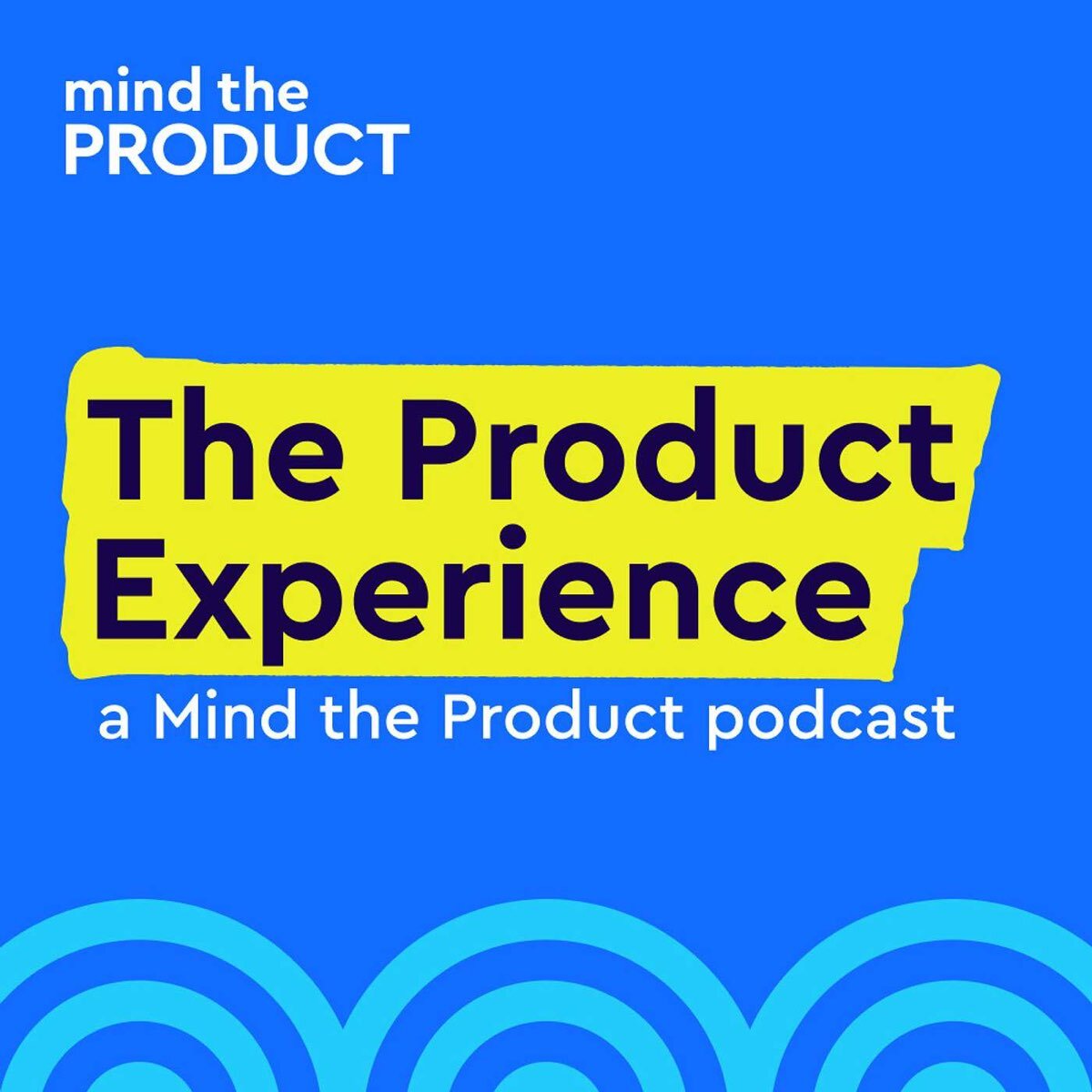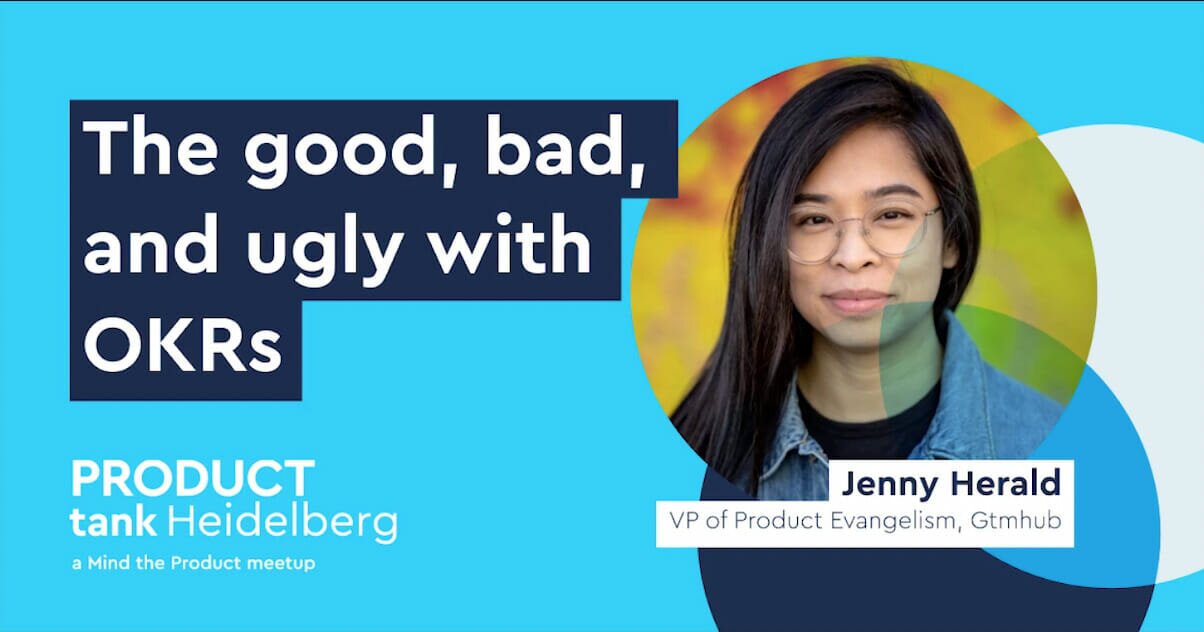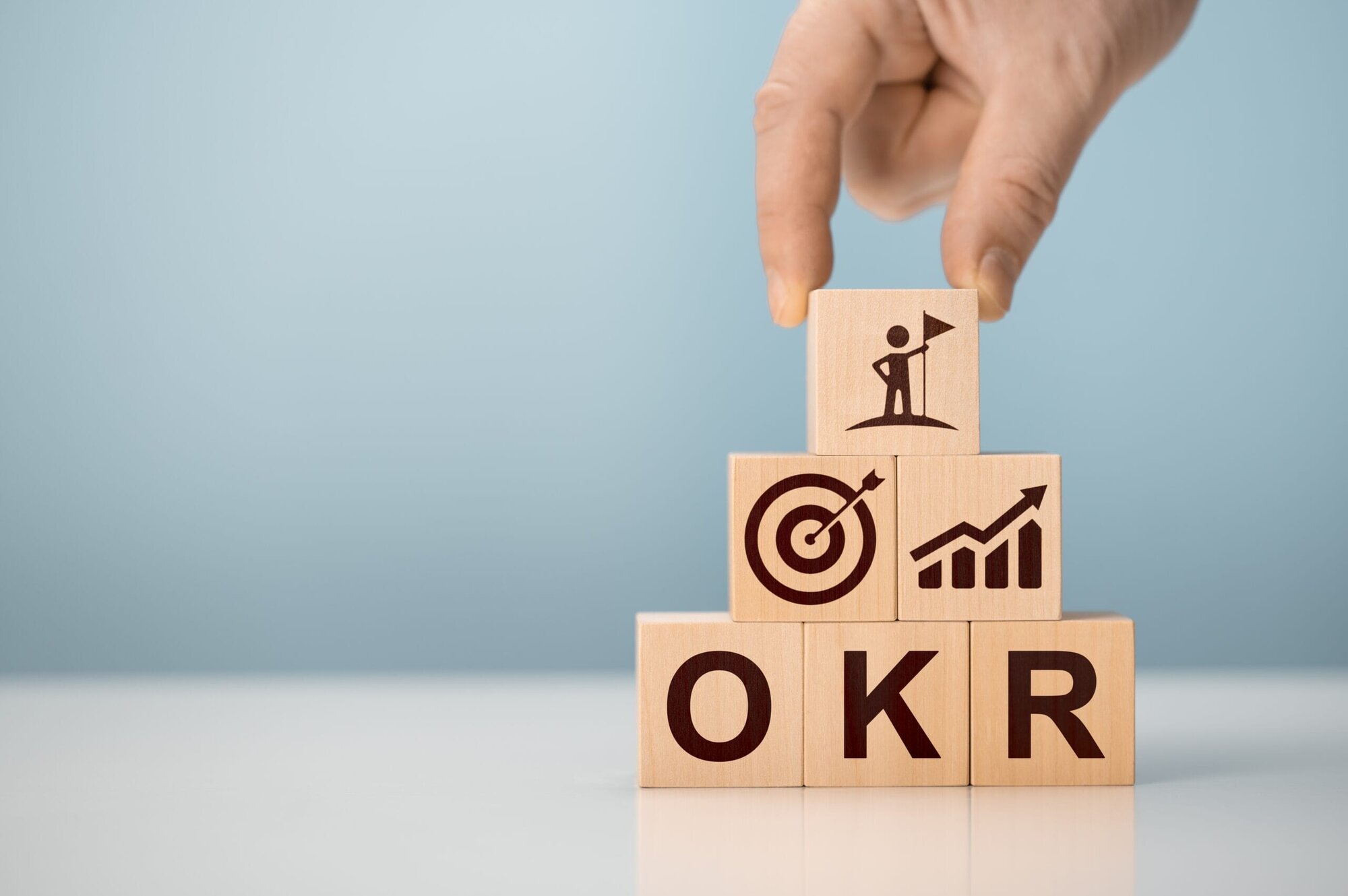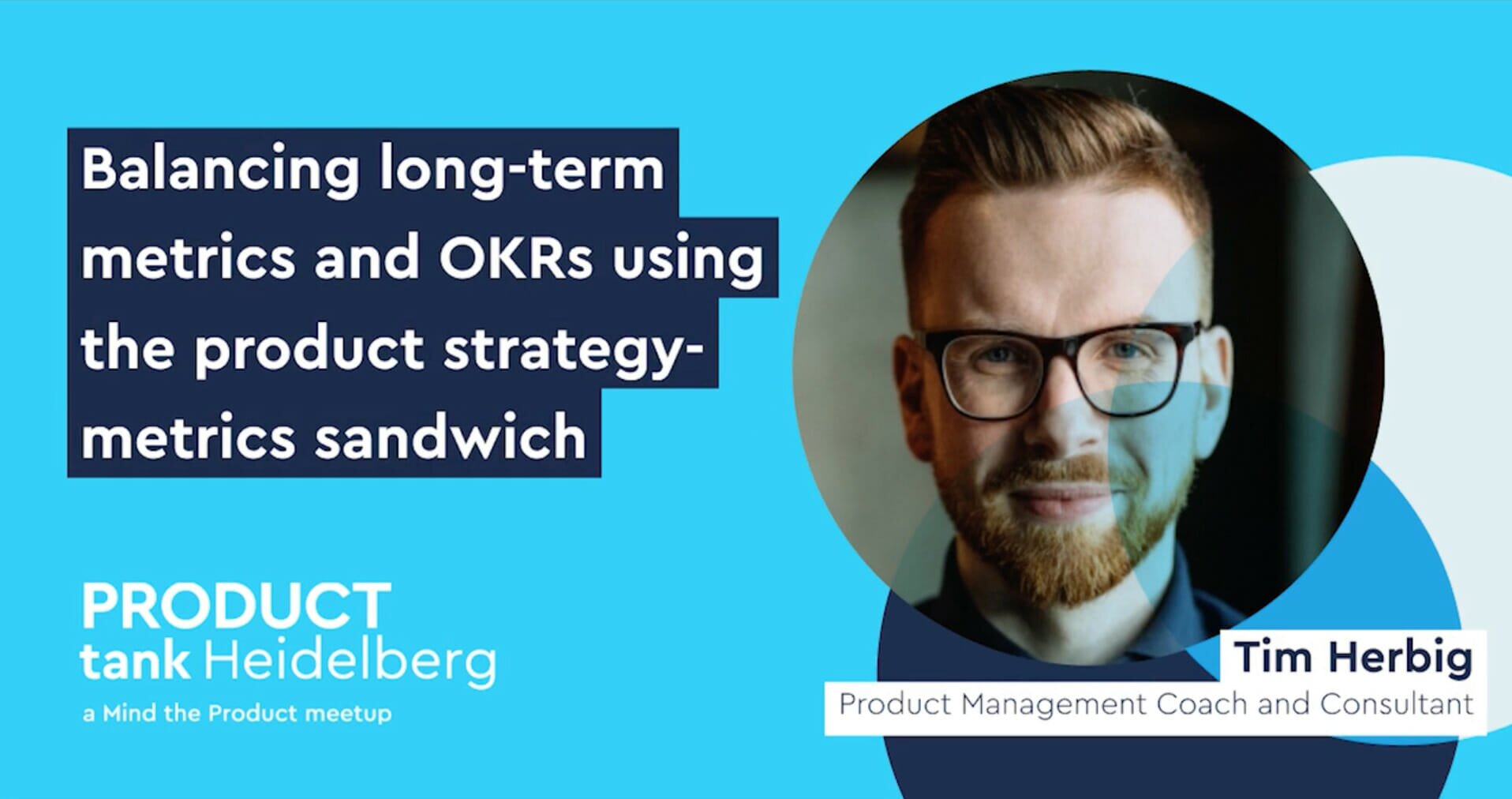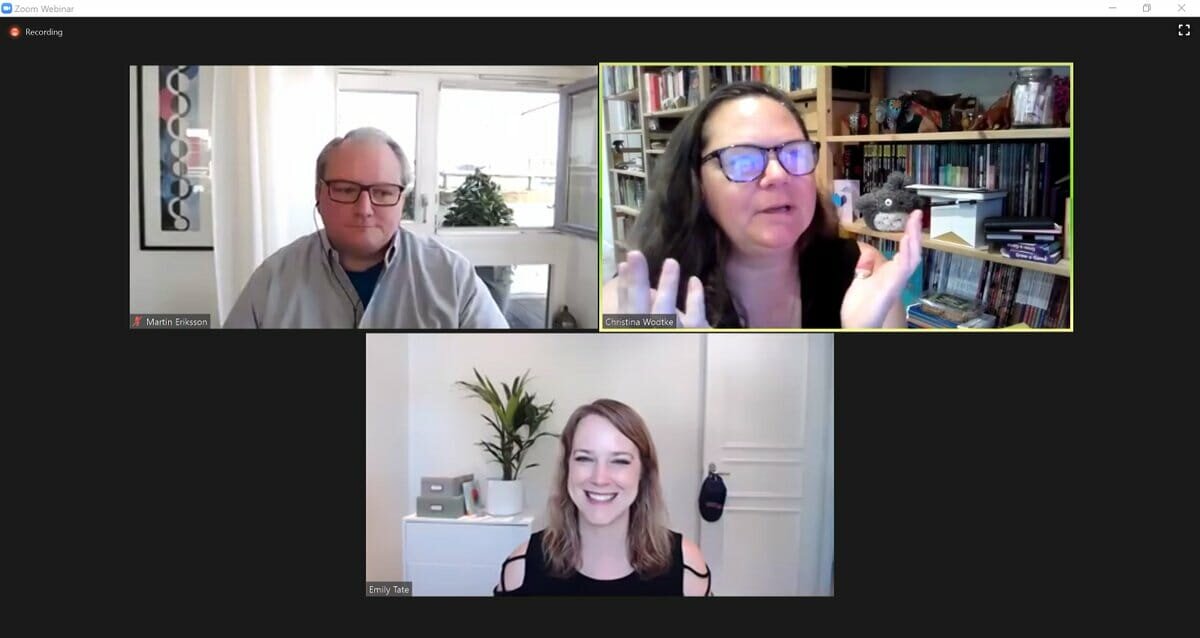We all know what OKRs are. Most of us use them or have tried to at some point. But it’s a much smaller group that have used OKRs well, and for their intended purpose. Natalija Hellesoe, co-author of OKRs at the Center, joins us on the podcast to chat about taking your practice to the […] Read more »
Featured links
Follow Natalija on LinkedIn and Twitter | OKRs at the Centre website | Natalija's virtual meet up group for OKR practitioners | 'What is an OKR? Definition and examples' What Matters feature
The post Putting OKRs at the Centre – Natalija Hellesoe on The Product Experience first appeared here on Mind the Product.
Episode transcript
Randy Silver:
Hooli it's that time of the year again,
Lily Smith:
Randy, I think you're a bit early for Christmas and also for Thanksgiving and Halloween. And I guess we've got the August bank holiday coming up in the UK and in America, you've got Labour Day, but what are you really talking about?
Randy Silver:
Sorry, I should have been more specific. We're coming up on the end of a quarter soon. So it's that time when product people the world over are working on their OKRs
Lily Smith:
Oh, okay, so you thought we'd help them out by just reminding them of this painful period?
Randy Silver:
No, I thought we might help them. I thought we should rerun our chat with Natalia. Hello, Sue. She's the co author of OKRs at the centre. And you know, there's so many ways to do OKRs badly and I have a feeling that we've both done OKRs badly once or twice in our lives, but Natalia is one that people can make it a bit easier to do them right.
Lily Smith:
This is actually a very good idea. Okay, great. Let's do this. The product experience is brought to you by mind the product.
Randy Silver:
Every week, we talk to the best product people from around the globe about how we can improve our practice and build products that
Lily Smith:
people love. Because it mind the product.com to catch up on past episodes and to discover an extensive library of great content and videos.
Randy Silver:
Browse for free, or become a minor product member to unlock premium articles, unseen videos AMA's roundtables, discounts to our conferences around the world training opportunities for
Lily Smith:
mining products also offers free product tank meetups in more than 200 cities. And there's probably one
Randy Silver:
of seemly keen rogues. Obsessive Kevin relaxing. Orange knapsack ripped. Ah, rang attempts kindly repurposing.
Lily Smith:
Hey, Randy, are you okay? What's up?
Randy Silver:
Oh, hey there, Billy. I'm just trying to come up with some new meanings for OKRs. So I can disguise them. I think quite a few companies have done them wrong. So they, you know, they end up with a bad rap.
Lily Smith:
Oh, I see. That. Yes, sort of makes sense. Or, you know, you could suggest to those companies and the people that are a bit jaded or confused that they get an organisational development coach, you know, like our friend Natalia Hala Zhu, who co authored okay as at the centre with Sonya muse.
Randy Silver:
See, this is why you're the smart one, Emily, that's a much better idea, or you know, even better than that, they can start by listening to our chat with Natalia where we covered what goes wrong, and why and how you can get your OKRs back on track, and you know, how to get started in the first place. So, let's get straight to that.
Lily Smith:
The product experience is brought to you by mind the product.
Randy Silver:
Every week, we talk to the best product people from around the globe about how we can improve our practice, and build products that people love,
Lily Smith:
because it mind the product.com to catch up on past episodes and to discover an extensive library of great content and videos,
Randy Silver:
browse for free, or become a mind that product member to unlock premium articles, unseen videos, AMA's roundtables, discounts to our conferences around the world training opportunities and more.
Lily Smith:
Mining products also offers free product tank meetups in more than 200 cities. And there's probably one near you.
Randy Silver:
Natalia, thank you so much for joining us on the podcast tonight. For anyone who doesn't already know who you are, who hasn't read your book, please give us a little bit of a background. Tell us who are you? How did you get into product stuff? And what are you doing now?
Natalija Hellesoe:
Yeah, thank you so much for the invitation really happy to be here on the podcast. So my name is Natalia and I speak to you here, located currently in Munich in Bavaria, and I support organisations when it comes to wanting increased focus autonomy or value creation. So I would call myself an organisational development coach because I work with very different target groups in the organisations. And one of the focus areas that I've been doing with my customers over the last couple of years have been OKRs. And I mainly got into that field from an employee point of view because I was working within an ecommerce company that recently introduced OKRs and I first came into contact with that new tool and yeah, kind of looked at it from a trainer point of view. You have an HR manager point of view, but also from a view of an Agile coach, that I became in that role as well. And so it was really interesting for me to see what kind of value tools like OPR can bring to an organisation from an employee point of view, but also looking at it from kind of the bigger picture because I was involved in many transformation and change projects over the last 10 years before I started my own business. And so I kind of tried to combine the tool, the Agile focus that I come with, from the E commerce side with kind of the broader picture view that I got, during my years working in the HR project management and change and transformation projects on the largest scale in organisations. And by that trend help organisations really, yeah, grow into the organisations that provide value for the customer. So it has a lot to do with leadership and responsibility and agile ways of working as well.
Randy Silver:
Okay, so two things. One, that beginning was the best elevator pitch I've ever heard in terms of adding organisational value. That's fantastic. I'm totally sealing that. Number two, if you've done all of those things, we've seen all the transformations. So you've seen everything that can possibly go wrong in an organisation, I'm guessing is that truth?
Natalija Hellesoe:
I wouldn't say everything. I mean, whenever you know, I get to know a new customer. And there's still things kind of down the road where you're just like, Huh, interesting that practice you? And I've never seen that before. But of course, I mean, there are certain patterns that come, you know, over and over again, and that you probably anticipate when working with certain customers or in certain areas or certain problems for sure,
Randy Silver:
yeah. So what was it about OKRs. So you say this is the thing that really adds value?
Natalija Hellesoe:
I would say for me, OKRs, one of the tools that really kind of bridge the gap between the long term goals that normally exist in an organisation one way or the other, and the daily tasks and the daily decision making. And what I often see in the teams I work with now, but what I've also experienced as an employee myself is there's a huge disconnect between these two things. So you've got the shiny company vision, maybe a strategy paper that somebody's you know, built up. And then you sit there on a daily basis, and you need to make decisions and you want to like, Okay, this doesn't really give me any orientation, you know, for my daily tasks for my daily decisions for my next steps. And so that's where OKRs come in for me. And that's where I really see one of the values that they can bring into that when you have the conversations in your teams or with your management team to talk about, if these are our long term goals, then what is now the next step that we need to undertake, based on the information we have right now based on our experiences based on the competencies we have, and maybe the strategic focus topics that we picked at the same time.
Randy Silver:
Okay, we definitely want to talk a lot about mastering OKRs. But for anyone who's listening to this, who's new to the concept, can you just start off? What is an objective? And what is the key result?
Natalija Hellesoe:
Yeah, sure. So objective, as I said, is one part of the objectives and key results. And it describes the next inspiring step that you need to undertake or that you want to undertake towards your purpose or your vision. So it's something that should be inspiring and should be motivating. It's something that is rather qualitative and reasonable. But at the same time, clear and concise, it should be understandable for everyone who reads the objective, it should be something that is independently trainable for the people who are responsible for that, and achievable within a certain timeframe, because without PRs, we're talking kind of midterm perspective, not long term perspective. So often, for example, three months, and it should, of course, mirror the priorities of whichever team it relates to. So kind of It answers the question, where do you want to go next? And then the second part of the objectives and key results are the key results. So the measurement criteria that you add, because writing down and inspiring goal isn't enough, but of course, you need to also answer how do we then really know whether we are on the right track towards achieving that goal or not. And so you also add measurable key results that are more on a quantitative side, and that look at the perspectives on the goal from kind of different angles and measure changes in relative or absolute numbers. And so they answered the question, Am I on the right track or not towards achieving this objective and so together, they kind of give you an so called OPR set that describes your next step and the measures towards it.
Lily Smith:
So we're gonna look at this from two different angles one, which is you know, getting started and the other which is, you kind of got started and things aren't quite going the way that you hoped. But thinking about it from a Getting Started point of view, I mean, we're talking about, from the vision all the way through down to your daily tasks, which is basically the whole organisation. So how do you get started with something that's kind of so huge, assuming that your business is quite large? And, you know, how do you begin to put that into your business,
Natalija Hellesoe:
I would say the most important thing, especially as you mentioned, it's huge is start small. And I cannot kind of repeat that often enough when it comes to OKRs. Because I've seen so many companies fail their approach when it does start to, you know, implement OKRs, and the whole it section or something like that, because it's a massive tool, and it's often a massive change also for the organisation. So what I usually recommend is really, to pick maybe a team or department who is interested to try out something new, like OKRs. And where you can actually create relate a certain value to the team. So no matter what the reasons might be, for the whole company could consider OKRs, like increasing the focus or improving the alignment, there has to be some kind of value created for the initial team or teams that also try out OKRs to somehow, you know, make it relevant for them as well. And then what I would like to do is to kind of invest in a certain amount of training and preparation doesn't mean like three months of in depth training and all the details, but just enough that people know. So what will be different when we use OPR? What do we need to get started? Maybe have a look at the long term goals? Do we actually have them in our team? So do we have a foundation to build OKRs upon, and then just get into practice mode and try it out? Because I think that's the second important point is, you can learn a lot about OKRs theory, but you will never find out what actually works and doesn't work for your organisation as long as you haven't tried it out. So get into practice mode really fast, and then iterate from there, see how it works, what doesn't for your organisation, and then kind of increase the scale maybe to a couple of teams, or even a whole department before actually making a decision? Also, if that's a tool that maybe solves the underlying problem you're trying to tackle or not.
Lily Smith:
So you've talked about it going from the vision and the mission and the purpose of the business. So that kind of seems like one critical dependency in order to get OKRs working well, what are the other key things that you need in place in order to start trying out? Okay, as
Natalija Hellesoe:
I often get the question like, is it necessary to already have kind of an agile culture or agile leadership in place for OKRs? To make it work? And I would say it certainly helps, I wouldn't say it's really a prerequisite and you cannot start without, but I would say a certain openness to new ways of working to take over responsibility in the teams is crucial to even get through the pilot phase. Because otherwise, what you often see in companies, it's that the tools get stuck somewhere. It's all dependent, you know, on management commitment, you set up the events like OKR, definitions and check ins but nobody shows up or you know, you just leave them out. So it's really kind of a Yeah, self motivated, pilot, that will be an important point. And the other thing is to really integrate it into what you're doing. I would say that is not as crucial at the beginning. But also when you continue to work with OKRs is kind of the idea, and how can you connect it to what you're already doing. So to kind of keep the hurdle slow, also for the tool. And that also needs some thinking and some time at the beginning. So I would rather recommend you not just, you know, dive into OKRs and just try it out, but maybe take a couple hours, maybe a workshop or two to find out. Okay, how can we best get started with motivated people? And people who are actually yeah, signing up for that on a voluntary basis? I would say that's crucial as well. No, totally.
Randy Silver:
One of the challenges I see for lots of organisations is that they don't actually know what they want to do. And so they adopt a framework instead of actually working on the fundamentals. And I'm firmly of the belief that no framework is going to solve a bad organisation. But when you have competing interests, a growth versus value or something like that, how do you get people working together to set the right OKRs?
Natalija Hellesoe:
That's a really good question. Yeah. One thing I like to start off with, especially when companies implement OKRs at the beginning, is to find out first why they want to deal with OKRs at all, because of course now it's a trend topic and Google does it you know, and everyone does is so sure, let's just adopt it in our organisation as well and everything will be wonderful. I mean, we know from many other methods that this is not the case. And so I really tried to find out, okay, what is the problem that you're at least trying to solve with OCR, you have the idea that OKRs might help you solving. And then I would also like to let them prioritise. And this is mostly the most challenging part also, for management teams, when it comes to OKRs. To really be clear on what is then our priorities, is it taken from your example growth? Is it more value creation? Is it to really improve the alignment over the next couple of months? Or what are we trying to tackle here, because that makes a huge difference also, on how you work with OPR in your organisation, and how you also integrate it into your business. And on the other hand, if you're not clear on that, before you start OKRs, they have a nice side effect, because all these topics will definitely show up in your PR definition. And that's one of the reasons why it's so much fun to work with companies with OKRs. Because I've never learned more about customers than doing OKR definitions with them. Because you have everything on the table, like from the long term goals from the internal conflicts from leadership issues from, as you say, growth versus value conflict. But at the same time, once it's all on the table, you might be able to address it. But then of course, you need to be able to do that and actively act on these issues that come up during the OCR process, maybe also on the leadership team.
Randy Silver:
Is there an art to handling that? Well,
Natalija Hellesoe:
oh, I would say, transparency helps a lot. Having also a culture where it's possible to talk about that. And what sometimes help us to kind of institutionalise also the feedback cycle in a way, I mean, OKRs have already that built into them as the iterative cycle. But to kind of really enforce that companies do reviews to OPR, retrospective kind of think about the learnings they want to implement in the next cycle, and help facilitate that kind of process in the organization's as well. And I would say for that, and either internal or external facilitator who is not kind of a mid step conflict situation really helps because he can get kind of challenging. Yeah. And you
Lily Smith:
mentioned about when you're implementing OKRs, kind of using the OKR principles? What are the aka principles?
Natalija Hellesoe:
What are the okiya principles? That's also a good question. I would say, Okay, our principles by itself are really close to what is commonly known as agile principles in some way. I mean, you have all the basics, kind of baked into the OKRs, by itself, so kind of iterative ways of working, you know, inspecting and adapting over time looking at shorter timeframes, looking at, you know, fast shipping of results and things like that. But I would say also, on the other hand, topics, like self organisation, self responsibility, as I already mentioned, but of course, it totally depends on how you work with OKRs in your company, because self organisation might not be something that you relate to OKRs at all, the way that you deal with them, when it's rather, traditionally may be cascaded down in a very top down type of way. But otherwise, I would say they can be very self organised, very self responsible, very agile, in some ways.
Lily Smith:
Have you worked with any organisations where they've tried to implement OKRs, but because of the culture of the organisation, it's been clear that actually, it's not a good fit in terms of the the tool,
Natalija Hellesoe:
yeah, had various experiences like that, especially when companies get to a point where they're, for example, one of my customers last year, they were building a new product organisation. So they had the idea, let's do everything different, you know, build a joint product organisation. And for that, we need new tools and new roles and the new organisational structure and everything at once. And so I came in there in the midst of the process, and I was dealing with the teams around OKRs. And, of course, there were so many things missing at that point in time later, if it didn't have a clear vision of the teams, they didn't really have clear roles and responsibilities that you could then also use in an OPR process. They were just finding out about their new dependencies and all that. I wouldn't say that the culture wasn't a fit at all, or it's not possible to work without prs. But it's CEF definitely kind of the hard path to take, because they can every iteration with the OIC ers you had all these conflicts that you needed to solve, you had all these issues bubbling up. And these were not issues that could just you know, be solved within a week or two, but I mean, structural organisational leadership issues that really took time. And that of course, also took away some of the value that OKRs might bring To these teams. So what I tried to do then was to really focus on okay, if that is still the environment that we're in right now, what kind of value can then OPR spring and for some teams that was increased focus, increased communication, kind of talking about what kind of shared goals we have at the moment at all, because they haven't never done that before. For some teams, it was more like okay, we do that in the organisation now, but it doesn't really bring us any value. And they were thinking about maybe skipping it for an iteration or two until other issues are solved. Yeah.
Lily Smith:
Is anyone else totally ready for mine? The products London conference happening in October. If you've been before, you're probably feeling a bit like me desperate for your MTP conflicts. And if you're new to it, this is the product conference not to miss. If you're a product person looking to advance your career, expand your network, get inspired and bring the best products to market, then this is for you. So what can you expect? Well, MTP con is known for that epic lineup of speakers, renowned product leaders with invaluable insights and tactics to share. They cover a range of exciting topics that will challenge and inspire you to step up as a product manager, always with something tangible to take away into your own product practice. And this year is a pretty special one too, as it marks a decade of MTB con. So I'm expecting cyan coloured cupcakes for sure. You can go fully digital for the two days or with a hybrid ticket, you can go digital on day one and in person at the Barbican in London for day two, very cool, find out more and book your ticket at mind the product.com forward slash London
Randy Silver:
something you just touched on there are lots of companies that are at different levels of maturity. And at this point, there are lots of companies that have tried OKRs or similar things and done them badly. And they're trying to reintroduce them almost creates an allergic reaction. So how do you deal with a company where it's been done badly and want to, but it still has the problems that you think OKRs can fix? How do you introduce it in that case?
Natalija Hellesoe:
Yeah, that's really a tough cookie. Like if people already you know, get into your training saying like, yeah, we've done that before, that didn't work. So you know, they already sit there, like, with huge restraints and say, like, let's find out, you know, if this time is any better, I would say one thing I always tried to do in these situations is find out what they have exactly done before. Because many companies say, Okay, we've worked with OKRs. But when you didn't talk to the people, you have a million variation of what that actually means or what that meant in practice. And what they then kind of now relate to when it comes to talking about OKRs. And so oftentimes, I then find out that what they do, has very little to do with what I would call I actually worked with OKRs to create some value for my teams. But what they maybe did is they copy pasted their roadmaps into OKRs. And and of course, they didn't see any value in using this additional tool. So kind of trying to be transparent about, okay, what were your experiences, and what is maybe a different approach that you can take now to create more value. At the same time, in these cases, it's really crucial to have maybe some of the leaders on board to really kind of get into the mood of let's try this again, let's give this another chance. Because without that foundation, it's really hard to get anywhere. And another point maybe is to talk to the team about okay, what is kind of the smallest version of OKRs, we could try out because what I often hear is that OCR is so much extra effort. And that's why we don't want to do it again. And that's why we gave it up. So kind of find really a super small experiment to somehow create value for this team and then build upon that. So not start with the decision to do OKRs all over again for the next few years. But find kind of Yeah, many common consultation that everyone can agree on.
Randy Silver:
I worked at one company and I'm sure I've mentioned this story before, they decided to introduce OKRs. And they brought in 10 objectives. And there were annual and there were no OKRs. So a little bit of a mistake. But there are plenty of companies that do it better than that but are still not doing it that great. They've been trundling along and doing it for a few years, but they're not getting incredible value. How do you start to Well, first of all, how do you recognise the problems where you're using OKRs but not getting the most out of them? And then how do you start turbocharging it to make sure you're actually using it to best effect.
Natalija Hellesoe:
So one thing I often share with companies then also to make it transparent and where they are or maybe in their journey is something that we recognised during all our work with the customers. And we also share in the OKRs, at the centre book is kind of the development that many companies take on their OPR journeys. So, for many companies in the first step, when they start working with OKRs, it's important to create focus to have transparent goals to at least get some kind of alignment in place. So they're not even thinking about value creation or autonomy at all, because this is kind of the first major roadblock, and once then OKRs are in place, then maybe to think about, okay, how can we increase value creation? How can we make more autonomous teams? How can we maybe even go to the point that we can get purpose driven? And so kind of to share that kind of knowledge of Nokia development and that them rate where they see themselves where they would like to be justified? Okay, what is the motivation here behind our prs? And then to maybe give them also some recommendations, what worked in other companies not to say, this is the blueprint that you can use, and that will fix everything, but maybe just get them thinking, okay, how can you maybe differ from your current approach to create a different type of value that you want to see in OKRs. So for example, if they haven't really reflected on the OPR process and their learning so far, so they basically did the same thing for the last two years, to kind of bring them to the point to start doing OPR retrospectives doing deep learning analysis, doing iterations of the process design also every three months to maybe get something going here, on that line as well. But as we said before, I would say that's, that's definitely a tough cookie when companies have already started. What I also see is that many companies need a different approach in different parts of their organisation. So for example, a customer I work with right now, I did an OPR assessment after their first two years working with that. And then I did in depth interviews with some of the most important parts of the organisation. And it was really surprising even to me how different their practical approach to OKRs was, how different their outcome and how different their understanding of even the basics what an objective, what a key result, what an initiative is, and how that goes together. So kind of looking into these differences, and maybe finding common denominators, what is important for the OCR process for the whole organisation. So for example, everyone should stick to a three months cycle, but then to also define, Okay, where can we give freedom to the teams to then design the OCR process according to their needs and their ways of working? So if you
Lily Smith:
have an okay, kind of champion, and or if you don't have an OKR champion, like, who should be facilitating all of that review, and everything and checking in to make sure it's working and to make sure everyone's on the same page in terms of what they think the Okay, I should be doing? And? And also, I have another question, which is, if you have a good OKR champion, making all of this happen, how long does it take to get to the point where you really see it working for your business?
Natalija Hellesoe:
Yeah, so um, there are, of course, different variations and how to, you know, have designated roles for OKRs. I like to work with two different roles. One is kind of an, what I would call an OPR process owner, now very similar to to Pio role in Scrum, but really somebody who is kind of a OKR change agent on an organisation level. So who keeps kind of the process up where all the feedback kind of relates to each other, and who is normally also my main contact in the organisation. So somebody that is really taken the responsibility for the OPR topic as a whole. And then I like to add kind of a team of OCR coaches, I think similar to what you just called champions, who would then support the teams more on a practical basis, kind of facilitate events and things like that. And so with, together with the OCR, process owner kind of form some sort of community of practice that can also you know, exchange information experiences and things like that. I would say, it's turned out to be really helpful for teams to have somebody who has a little more knowledge and they themselves to facilitate the OPR processes so that the team can really focus on the definition on solving their issues, on the discussions on the content and so on. And I would say really interesting roles for that can be if you've already have, for example, agile coaches, Scrum, masters, facilitators, trainers, HR people, so anyone who's already involved in team coaching and facilitation can easily take over these kinds of OPR roles. For a process owner, I would always recommend to have Somebody who has kind of a bigger picture view on the organisation doesn't necessarily have to be somebody from the top management, but someone who is rather more and yeah, organisational development perspective than a team development perspective. Because once you scale up OKRs, and your whole organisation, it kind of adds a huge level of complexity that you need to oversee as well in that process. And to your second part of the question, so how long does it take? I would say, when you start off, for example, also, with external help, my goal is always to get out of the process as soon as possible by building up internal resources. On the other hand, most companies I know they stick with OPR coach roles for at least a couple of years, maybe even longer, but that totally depends on I would say the maturity of the teams in leading processes, leading meetings and things like that. So if you implement OKRs in a mature scrum team, I think maybe the scrum master can take over the cultural a bit and and it's easy to shuffle the responsibility within the team after two or three cycles. But if you introduce OKRs, in a rather traditional team, where kind of this type of cooperation is also new, and also kind of coming with the implementation of OKRs, it might be a good idea to keep these roles a little longer.
Randy Silver:
The OKR coaches, it sounds like it can be a role that people do in addition to their day job. But the OKR process owner is that something you do as your sole focus for a while, or is that something that's also assigned responsibility of somebody else.
Natalija Hellesoe:
And most companies I worked with, that's also just kind of a side job that people have, at the same time, or when you Yeah, implement OKRs on a broader scale in your whole organisation, the process owner role might grow with that. So for example, when you start off with a member of the management team, who just has that as a little side job, you will quickly hit the point where they say, okay, that's too much responsibility, too many topics to oversee. So it might be useful to have somebody else in your organisation or even a tandem to take care of that. But I've rarely seen it happen that people really have full time roles to take care of that. On the other hand, the OPR coaches, I've seen many companies where they have maybe three or four really designated full time roles to do the OPR coaching then for the entire organisation that worked quite well.
Lily Smith:
And presumably those Okay, our coaches help each of the teams kind of rate and review all of their OKRs as well. And check that it's all cascading nicely down through the business or up through the business, whichever way. But if you if you don't have those roles in place, do you have any kind of tips for sort of successfully checking that you have that cascading all the way through the business in a way that makes sense and and helps with alignment? And doesn't kind of cause jarring confusion?
Natalija Hellesoe:
Yeah, there's certainly I would say, rather easy things that you can do. First of all, I think it's really helpful to have a common understanding of, as I said, what an objective is, what a key result is what we actually wants to do with the New York era cycle and so on. And I mean, that sounds totally basic. At the same time, most companies I work with who've worked with OKRs for quite some time, it's not in place. So just to have that maybe written down or something like a rough checklist for your organisation. So for us, it's important that objective, fulfil these type of criteria, and you can just bring that to your next OPR workshop. For the alignment part, I would say it totally makes sense to also have clarity around the process there. So be clear. Also, from the management point of view, is it a top down cascading process? Is it a really bottom up feedback process? Or is it something in between? And how do then the OKRs sets get created? So do we give input first to the teams give input first, who needs to schedule which which meetings, so to make it most efficient, and also over time, and then to find maybe workshop formats where the discussions can happen that needs to happen over the alignment process. So for example, when the teams prepare their OPR sets, and maybe the company leaders have a certain idea to then bring people together in a workshop format to talk about remaining issues maybe also already talked about resources, kind of get a rough alignment in place before then maybe going into the teams again to figure out the details. But also here the my invitation would really be to get to experiment with what works best for the situation you have in place in your organisation how much alignment you need. But if you want to start with something I would always recommend short workshop formats where people come in people Hear it and can then solve most of the issues already in the communication format.
Randy Silver:
Natalia, I'm learning a tonne about every mistake I've ever made. So just to continue focusing on the mistakes I've made, what are the signs that you're doing OKRs wrong, that you know, you've had them in the organisation, your organisation might think that they're doing it right. But what are the telltale signs that we're just not getting there?
Natalija Hellesoe:
I would say the most important sign for me is when I then just randomly ask anyone like, Oh, why do you do OKRs? And they're like, Yeah, because we have to. Like, okay, that's a definite sign for me to ask more questions. Okay, why is this stuff in place? You know, what is actually its reason for existence, no matter how, yeah, how sufficient it might seem for the organisation. And of course, the other sign that I'm always looking at is, what is actually the content of their OKRs? Does it look like a to do list? Is it something that I would maybe also understand, from an external point of view? Is it kind of clear what the goals are in there? Can people work with that? And another sign might also be, do OKRs come up somewhere else in the organisational processes? Or is it just something they do? And they put into a tool? And they look at them again, three months after? So are they somehow integrated in any way do people work with them? Do they actually help them in their decision making or not? So that's something I would definitely look for. And also, when it comes to the complaints that people might raise around OKRs, especially the effort part, that would also be something that I would look into, okay, if people are just complaining takes way too much time, that's a definite sign that they might not really get any value out of that. So let's definitely change that for sure, as well. Or otherwise, maybe even get rid of OKRs, because they've got more important problems, where other tools might be a better option.
Lily Smith:
And aside from the complete opposite of what you've just said, Randy, kind of like major signs of, yes, this organisation has nailed OKRs. And they are completely working.
Natalija Hellesoe:
I would say, I had an interesting conversation with one of my customers lately about that. And the feedback was that people kind of scheduled the next OCR workshop themselves, because they said, like, we learned so much through the OCR definition, we get not just Valley out of that, but just, you know, learn so much about our team, our organisation about our next steps, we definitely want to do that again. So to kind of to set kind of this, this motion in the teams kind of have this this motivation behind that topic. That's a definite sign. And on the other hand, I mean, if you look at it from a business point of view, can you actually connect OKRs and what they bring to the organisation to improve the value that you create in your organisation? Because I mean, Nokia should never be a tool that is just there to, you know, help you and make your processes more efficient. But does it actually help to solve any problems of the customers as well? I would say if you get that far without PRs, then they're doing definitely some good.
Lily Smith:
Awesome, Natalia. It's been so great talking to you about this. I think, okay, ours is just such a hot topic, because it's grown so rapidly, and so many companies are kind of willing to try something new and but not necessarily hitting the nail on the head. But yeah, thank you so much for enlightening us with lots of very good advice.
Natalija Hellesoe:
Well, thanks a lot for having me. It's been a pleasure
Randy Silver:
to tell you before we let you go for anyone who needs desperate help in doing OKRs, right? Where do they reach you?
Natalija Hellesoe:
Well, they can reach me on LinkedIn and also on my website, OKRs data centre.com And find me and my monthly OPR meetup. So that might be a good source of inspiration. If you just want to get started, you know, get some new ideas. I always have guests there every month to talk about their own experience, their own failures and what worked for them. I think there's always a tonne to learn for everyone including myself.
Randy Silver:
Fantastic. And we'll have a link to all of that in the show notes. Thanks again Natalia.
Lily Smith:
The product experience is the first and the best podcast from mine the product. Our hosts are me, Lily Smith, and me Randy silver. Louron Pratt is our producer and Luke Smith is our editor.
Randy Silver:
Our theme music is from humbard baseband power. That's P AU. Thanks to Arnie killer who curates both product tank mtpa engage in Hamburg and who also plays bass in the band for letting us use their music. You can connect with your local product community via product tank regular free meetups in over 200 cities worldwide.
Lily Smith:
If there's not one near you, maybe you should think about starting one. To find out more go to mind the product.com forward slash product thank you.
